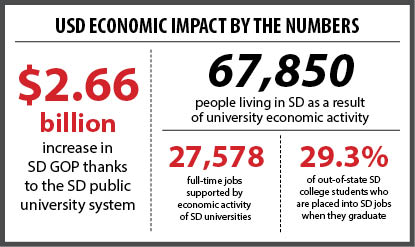
Economic survey estimates universities’ impact on South Dakota
The Board of Regents recently commissioned USD economics professors Mike Allgrunn and Travis Letellier to conduct a study centered around the economic impact of the South Dakota public university system.
The study concluded that 67,850 people are living in South Dakota as a result of the economic activity created by the universities.
To conduct the study, a survey was sent out by email over the summer months to alumni, staff, the Board of Regents and students enrolled in any of the six regental universities in 2016.
Allgrunn said they received 12,425 usable responses from those groups.
Letellier said the report applies to everyone living in South Dakota, not just university students and faculty.
“The numbers in the report are statewide impacts,” Letellier said. “People don’t realize that this report applies to them. Our goal really was that we want the report to be user-friendly (with) short, sweet, big numbers so people can look at it and understand.”
Mike Rush, Board of Regents executive director, wanted the study to be done to show legislators that the universities are a sound investment for the state.
“We spend a lot of time talking to legislators about various pieces of legislation and the board has a legislative agenda,” Rush said. “I spend a lot of time advocating for the university system.”
By 2020, more than 65 percent of South Dakota jobs will require post-secondary credentials, according to the study. Rush noted that the state should try to be more ambitious when it comes to higher education.
“To remain competitive, we actually need to have a competitively educated population,” Rush said.
The study also concluded that 29.3 percent of out-of-state students are placed in South Dakota jobs by the time they graduate.
“If we didn’t have those people in our state, we couldn’t operate the economy that we have in place,” Rush said. “South Dakota just doesn’t have enough people to populate all the jobs that we have available. Those out-of-state students and the ability to recruit out-of-state workers contribute to our economic success.”
Rush said the public university system creates some of the highest-paying jobs in the state. He also recognized the fact that South Dakota schools compete on an international level.
“The primary way our universities benefit the state is by training qualified people to live and work in our society,” Rush said. “The best-paying jobs in the economy in the last five years were people in higher education. The economic impact of those was that the study was a benefit to students and we can compete with the world.”
Allgrunn said not only legislators, but taxpayers and the public should know about the economic impact of universities.
“The Board of Regents was interested in showcasing higher education to the legislature in particular, but also to voters and other constituents,” Allgrunn said. “Yes, it’s a cost to taxpayers, but there are also some benefits. They wanted to show the investment side of it.”
The thousands of people who are in this state thanks to the universities have quite an impact, Allgrunn said.
“That’s the people who are directly part of the university, so students, faculty, but also all of the supporting industries that exist because of that extra population,” Allgrunn said. “Just think of anything not directly related to the university that you know is (in South Dakota) because of the university.”
Allgrunn applied that same thought to Vermillion.
“The university means a lot for Vermillion,” Allgrunn said. “USD obviously benefits from a lot of the things that Vermillion provides, and Vermillion benefits greatly from having the economic benefit and population that exists here because of the university.”


